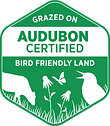
What We Do
Reinhabiting our role as a keystone species...
We work with like minded cattle producers to bring on organic grass-fed cattle during our “growing season,” fluctuating our stocking rate and arrival/departure dates based on the wide variation in seasonal precipitation we receive. This flexibility ensures that we do not overgraze our pastures and that we have enough grass to keep the cattle fat and happy.
We move our cattle in one large herd through a series of paddocks using low-stress stockmanship, and temporary electric fencing to provide the grass sufficient recovery time between grazes. Within three short years of management we have seen tremendously encouraging results in the diversity, abundance, and resilience of our grasslands.

Benefits of Regenerative
Grazing
Adaptive Rotational Grazing regenerates and nourishes our grasslands and savannas; nutrient dense beef is the byproduct of that management:
Grass turns sunlight into carbon, day in and day out. As soon as a bite is taken out of the grass, it sends a surge of carbon out through its roots and into the mycorrhizal fungi that live in the soil. In exchange, the fungi provide the grasses with the essential nutrients they need to grow new blades. By this mechanism, carbon is pulled out of the atmosphere via photosynthesis and is stored in the soil, directly combating climate change. As long as the grass has a sufficient amount of time to recover before the cattle return, it will grow healthier and stronger roots, feed the diverse and essential soil microbes, and stay vegetative and photosynthetically active for a longer portion of the year.

Why it Works....
At Keystone Land and Livestock, we mimic natural cycles of grazing that benefit our grasslands and savannas.

Mimicking Evolution
Grasses and grazers co-evolved over millions of years. Ruminants, such as cattle, bison, and sheep, have the incredible ability to utilize their four powerful stomachs to turn these coarse, minimally nutritious blades into nutrient dense meat. However, the grass also needs the grazers in order to thrive. Grazing animals remove old dead leaves to make room for new plant growth, fertilize the pasture by spreading little piles of compost across the land, lightly break up soil crusts with their hooves and create micro-variations in the topography, which allows grass to germinate. Their saliva even contains microbes that stimulate grass growth. So if cattle are so good for grasslands, why does grazing get such a bad rap? The key to creating a positive ecological impact with cattle is how those cattle are managed.

Rest & Recovery
Grasslands co-evolved with herds of migrating grazers. Thousands of ruminants would travel in migratory cycles, at times grazing in dense groups to protect themselves from predation, eating, trampling, and defecating on the grass, before moving on to greener pastures, often not returning for months or even years. This provided time for the critical factor in healthy grasslands and good grazing management: Recovery. The grasses must have sufficient time to regrow the leaves and roots that are defoliated during a grazing event. So long as they are provided adequate rest, they will recover with deeper roots, more blades, and stronger connections to the microbes in the soil. Without this critical component of recovery, the virtuous cycle of grazing becomes a destructive one.

Breaking the Cycle
Wild herds of ruminants were largely exterminated in the United States, replaced by private property and domesticated ruminants. Predators were eliminated, and cattle were allowed to roam freely across large areas of open rangeland. With no incentive to migrate or stay in a herd they simply find the most palatable forages, and graze them continuously, taking a new bite every time the grass starts to regrow, until its energy reserves are depleted and it dies. The diversity and abundance of grasses drop precipitously, with some grasses overgrazed to death, with others under grazed until their old growth chokes out new growth and prevents germination of new seeds. Over decades this leads to ranches that are low in diversity and productivity, with eroding gullies, degraded riparian areas, and unhealthy soils.
Humans as Keystone Species

In the absence of predators, larger herds of native ruminants, or vast contiguous grasslands, we assume the role of the Keystone Species; facilitating the conditions to restore this ancient relationship between grass and grazer.
We control three factors in order to do this:
-
Timing - when the herd is put into a paddock
-
Density - how many cattle relative to the size of the paddock
-
Duration - how long they are in the paddock
We are constantly planning for and monitoring the recovery of the pastures we have already grazed. Cattle don't return to a paddock until the grass is fully recovered and ready to be grazed again. This varies according to the time of year, as grass grows slowly during the cold winter months but quickly in the spring. Furthermore, we fluctuate both our stocking rate (ie. how many animals are on the ground) and our grazing season (ie. how long they are there for) based on the wide variation in seasonal precipitation we receive in California. This flexibility mimics the natural variation in ruminant numbers and migration timing that would naturally have existed in pre-colonial California.
Partnerships & Certifications









